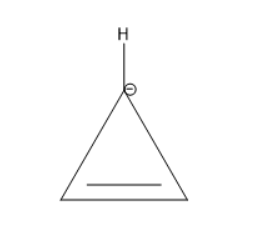
Why isn’t cyclopropene aromatic?
Answer
398.4k+ views
1 likes
Hint: To answer the question let us talk about aromatic compounds. Aromatic compounds are the class of unsaturated compounds that are highly stable. The property responsible for their stability is called Aromaticity. Some important examples of aromatic compounds include benzene, toluene, pyridine, thiophene, etc.
Complete answer:
In the question, we are asked why cyclopropene is not aromatic. To answer this let us discuss important conditions of aromatic compounds.
Conditions of aromatic compounds-
(A)The compound must be cyclic
(B)The compound must be planar i.e. has
(C)The compound must be conjugated i.e. shows delocalization of pi-electrons.
(D)Must obey Huckel’s rule i.e. it has
A compound must obey all of these conditions to be aromatic.
Let us now talk about the compound cyclopropene and first look at its structure-

Let us see if this molecule obeys all the conditions of the aromatic compound-
(A)The compound is cyclic so this condition is fulfilled.
(B) 2 of the carbon are
(C)The compound is not conjugated due to the
(D)The compound has 2 pi-electrons; it means it obeys Huckel’s rule.
So overall we see that the compound does not obey all the rules and is hence not aromatic. This cyclopropene molecule belongs to the category of non-Aromatic compounds.
Additional Information:
Apart from the category of Aromatic compounds, we have a class of compounds called anti-Aromatic compounds in which all conditions are fulfilled except that it does not obey Huckel’s rule and instead follows the
So if we look at the cation and anion of cyclopropene we will get the following results-

This is cyclopropenyl cation. If we look at this compound all the conditions are fulfilled and the molecule is planar as well as conjugated (all the carbons are

This is cyclopropenyl anion. If we look at this compound it obeys all conditions except Huckel’s rule and it obeys
Note:
The correct order of the stability of compounds is -Aromatic>non-Aromatic>anti-Aromatic. Cyclopropene is the simplest cycloalkene. It has the general formula of
Complete answer:
In the question, we are asked why cyclopropene is not aromatic. To answer this let us discuss important conditions of aromatic compounds.
Conditions of aromatic compounds-
(A)The compound must be cyclic
(B)The compound must be planar i.e. has
(C)The compound must be conjugated i.e. shows delocalization of pi-electrons.
(D)Must obey Huckel’s rule i.e. it has
A compound must obey all of these conditions to be aromatic.
Let us now talk about the compound cyclopropene and first look at its structure-

Let us see if this molecule obeys all the conditions of the aromatic compound-
(A)The compound is cyclic so this condition is fulfilled.
(B) 2 of the carbon are
(C)The compound is not conjugated due to the
(D)The compound has 2 pi-electrons; it means it obeys Huckel’s rule.
So overall we see that the compound does not obey all the rules and is hence not aromatic. This cyclopropene molecule belongs to the category of non-Aromatic compounds.
Additional Information:
Apart from the category of Aromatic compounds, we have a class of compounds called anti-Aromatic compounds in which all conditions are fulfilled except that it does not obey Huckel’s rule and instead follows the
So if we look at the cation and anion of cyclopropene we will get the following results-

This is cyclopropenyl cation. If we look at this compound all the conditions are fulfilled and the molecule is planar as well as conjugated (all the carbons are

This is cyclopropenyl anion. If we look at this compound it obeys all conditions except Huckel’s rule and it obeys
Note:
The correct order of the stability of compounds is -Aromatic>non-Aromatic>anti-Aromatic. Cyclopropene is the simplest cycloalkene. It has the general formula of
Recently Updated Pages
Master Class 9 General Knowledge: Engaging Questions & Answers for Success

Master Class 9 English: Engaging Questions & Answers for Success

Master Class 9 Science: Engaging Questions & Answers for Success

Master Class 9 Social Science: Engaging Questions & Answers for Success

Master Class 9 Maths: Engaging Questions & Answers for Success

Class 9 Question and Answer - Your Ultimate Solutions Guide

Trending doubts
State and prove Bernoullis theorem class 11 physics CBSE

What are Quantum numbers Explain the quantum number class 11 chemistry CBSE

Write the differences between monocot plants and dicot class 11 biology CBSE

Who built the Grand Trunk Road AChandragupta Maurya class 11 social science CBSE

1 ton equals to A 100 kg B 1000 kg C 10 kg D 10000 class 11 physics CBSE

State the laws of reflection of light




